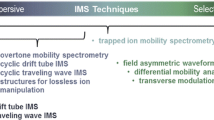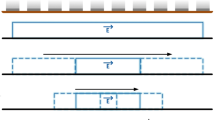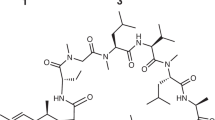Abstract
A panel of 15 biological toxins ranging between ~60–28,000 g/mol was used to evaluate the feasibility of screening aqueous samples for toxin analytes based on their translational diffusion coefficients, D t. Toxin D t values were measured by pulsed-field gradient 1H NMR spectroscopy using a bipolar pulse pair, longitudinal eddy current delay pulse sequence incorporating water suppression to achieve the maximum dynamic range for toxin signals. To collect data for an effective screening protocol, reference D t values were determined from five independent measurements at both 25 and 37 °C for all toxins in the panel. In the protocol, D t values are measured at both temperatures for a suspected toxin target in a sample, and for assignment as a potential toxin analyte, the measurements are required to fall within ±0.25 × 10−6 cm2/s of both reference D t values for at least one toxin in the panel. Only solution viscosity was found to influence sample D t measurements appreciably; however, the measurements are easily corrected for viscosity effects by calculating the D t value of the suspected toxin at infinite dilution. In conclusion, the protocol provides a rapid and effective means for screening aqueous samples for all toxins in the panel, narrowing toxin identification to ≤2 possibilities in virtually all cases.


Similar content being viewed by others
References
Rowe-Taitt CA, Anderson GP, Lingerfelt BB, Feldstein MJ, Lighler FS (2002) Anal Chem 74:6114–6120
Rowe-Taitt CA, Hazzard JW, Hoffman KE, Crass JJ, Golden JP, Ligler FS (2000) Biosens Bioelectron 15:579–589
de la Torre JG, Bloomfield VA (1981) Q Rev Biophys 1:81–139
Leung HO, Marshall MD, Cashion WT, Chen VL (2008) J Chem Phys 128:064315
Dais P (1995) Adv Carbohydr Chem Biochem 51:63–131
London RE (1989) Methods Enzymol 176:358–375
Stejskal EO, Tanner JE (1965) J Chem Phys 42:288–292
Wu D, Chen A, Johnson CS Jr (1995) J Magn Reson, Ser A 115:260–264
Cantor CR, Schimmel PR (1980) Biophysical chemistry part II: techniques for the study of biological structure and function. Freeman, New York
Altieri AS, Hinton DP, Byrd RA (1995) J Am Chem Soc 117:7566–7567
Sophianopoulos AJ, Rhodes CK, Holcomb DN, Van Holde KE (1962) J Biol Chem 237:1107–1112
Dubin SB, Clark NA, Benedek GB (1971) J Chem Phys 54:5158–5164
Uedaira H, Uedaira H (1970) J Phys Chem 74:221–2214
Yu X, Cai S, Chen Z (2004) Spectrochim Acta A Mol Biomol Spectrosc 60:391–396
Henderson TJ, Cullinan DB, Lawrence RJ, Oyler JM (2008) J Forensic Sci 53:151–161
Acknowledgment
The opinions expressed herein are the private views of the author and are not to be construed as official or reflecting the views of the Department of the Army or the Department of Defense.
Author information
Authors and Affiliations
Corresponding author
Additional information
This article is a US Government work and is in the public domain in the USA.
Rights and permissions
About this article
Cite this article
Henderson, T.J. Feasibility study for the rapid screening of target molecules using translational diffusion coefficients: diffusion-ordered NMR spectroscopy of biological toxins. Anal Bioanal Chem 396, 1465–1471 (2010). https://doi.org/10.1007/s00216-009-3349-9
Received:
Revised:
Accepted:
Published:
Issue Date:
DOI: https://doi.org/10.1007/s00216-009-3349-9




